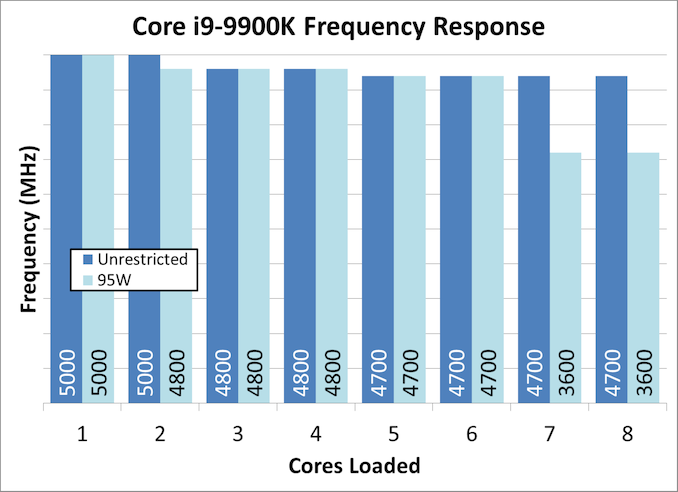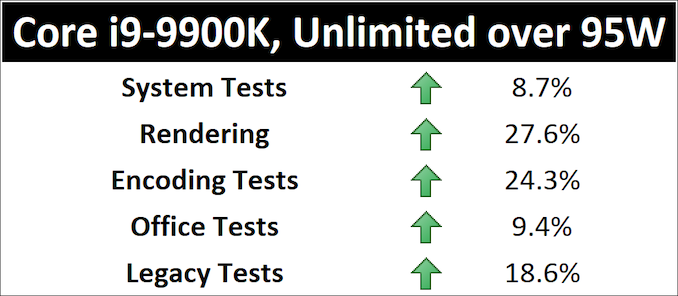The Intel Core i9-9900K at 95W: Fixing The Power for SFF
by Ian Cutress on November 29, 2018 8:00 AM ESTCore i9-9900K in Small Form Factors
Even with all the hullabaloo surrounding how Intel defines TDP and what values the company should actually be advertising for the power consumption of its processors, the simple fact is that processors generate thermal energy when they run. Sometimes it’s a small amount, and sometimes it’s a lot, but in every case that thermal energy has to be managed, either by the box cooler, some super extreme water chiller loop, or by a super massive fanless heatsink. In order to maintain performance, the thermal solution also has to be suitable for the environment at hand.
Nothing proves more channeling than designing a system for something small, and still maintaining high levels of performance. There are tradeoffs – performance for noise, or silence for performance. One way to manage this is through configuring the turbo and power values of the system in the firmware, and it is this method that OEMs use for laptops and mini-PCs.
Some Performance Loss, But More Efficient
The performance that Intel guarantees is the one on the box: the base frequency at the sustained TDP. For system integrators or builders, this gives a simple comparison point, and when we set our power consumption limits for the Core i9-9900K, this is what we saw at full load: 95W gave 3.6 GHz at 7-8 core load.
Losing almost half the power from standard operation caused the frequency to drop by 23% at the fast and furious end, which has a knock-on effect on performance. As was perhaps to be expected, for our throughput benchmarks, it was sizeable. For this data, we’re going to represent the performance uplift from 95W to the ‘unlimited power’ mode:
The system and office tests, which are a mix of latency and throughput tests, saw just under a 10% gain going from 95W to unlimited mode. For pure throughput however, that 23-24% difference in frequency gave an equivalent gain to the unlimited power mode. The only flipside is power: the extra performance pushes power consumption to 164-165W, which is a 74% power gain. If we were going for performance per watt, then the 95W wins that battle very easily. It all depends if the form factor the processor is in can provide sufficient cooling.
Doing these numbers gave me an idea for a metric for power efficiency. We currently run our power tests during a run of POV-Ray, and as a result, we can plot the power consumption during our POV-Ray test against the POV-Ray result score.
The highest performers are at the low end of the spectrum of what we’ve tested, with the Ryzen 5 2400G and Core i5-8305G (Kaby Lake-G) being the top performers, getting an efficiency rating (score/power) of 67 and 53 respectively. However Intel’s Skylake-X parts and the Threadripper 2990WX all scored highly on this metric too, around the 43 mark. This is likely because these high-power processors actually give less power per core, and each core is nearer to its peak efficiency for frequency/voltage.
The Intel Core i9-9900K, in normal operation, scores an efficiency rating of 32.9. This rises to 44.2 if the processor is fixed to 95W. This ultimately puts the 9900K in the limelight for an SFF system: when the power is limited to 95W, you get all the single core performance, most of the variable threaded performance, and around a 10-27% loss in throughput testing, most noticably in rendering. Overall, it acts like a 9900K in single thread mode, and like a 9700K in multi-thread mode.














101 Comments
View All Comments
TechSideUp - Sunday, December 2, 2018 - link
Can you show me where your getting this i9-9900k for $488? Lolpeevee - Monday, December 3, 2018 - link
" Alex Yee, a researcher from NWU and now software optimization developer, that I realized that he has optimized the software like crazy to get the best performance."What CPU he optimized it for? Let me guess... the one he has in his room.
tviceman - Monday, December 3, 2018 - link
I'd like to see what kind of performance gains may be had with an undervolt when TDP limited.TheJian - Tuesday, December 4, 2018 - link
I think people are confusing WATTS USED with TDP (amount of HEAT a chip puts off that your HSF or case etc has too be able to accommodate to cool said chip). They are telling manufacturers of laptops, pc's etc how good their cooling design needs to be to keep the chip from heating up.THERMAL DESIGN POWER (point might be more accurate, as some use it), is just as it sounds. THERMAL, er, uh, HEAT. Get it? I'm confused by everyone's confusion...LOL.
https://www.windowscentral.com/what-tdp-and-why-sh...
Perhaps a bit better explanation than anandtech is providing. Maybe they need an A+ course?
"TDP ≠ power draw?"
"Not quite, no. TDP doesn't equate to how much power will be drawn by the component in question, but that doesn't mean you can't use the value provided as an estimation."
"TDP is not — however — a direct measure of how much power a component will draw, but it can be a good indicator."
So, don't expect watts PULLED from a wall to equal a quoted TDP. That isn't what it is, although it may come close to meaning it...ROFL.
If you had a 100% efficient chip (as someone else noted isn't possible...yet?), your chips TDP rating would be ZERO. It would not require anything to cool it. See the point?
https://en.wikipedia.org/wiki/Thermal_design_power
"The thermal design power (TDP), sometimes called thermal design point, is the maximum amount of heat generated by a computer chip or component (often the CPU or GPU) that the cooling system in a computer is designed to dissipate under any workload."
Not exactly watts used right?
https://fullforms.com/TDP
"What does TDP mean?
Thermal Design Power (TDP), sometimes called Thermal Design Point, is a metric that is expressed in watts. TDP refers to the amount of power/heat a cooling system (like fan, heatsink) is expected to dissipate to prevent overheating."
Again, not watts used. I could point to another dozen, but people should get the point. Despite whatever Intel/AMD think it means year to year (ROFL), it's heat.
https://www.overclockers.com/forums/showthread.php...
Same story from OC people. To each his own I guess, but many seem confused about why things blow past tdp (because it's not WATTS). What is the chips temp when it blows past those TDP numbers at stock settings? Is it 150 instead of 95 or whatever? I mean if Dell or someone designs their slim pc's for 95w it likely won't work to well if it's going to 150 temps with a box that is designed to cool 95-100w right? Again, the definition used here really don't work IMHO (and everyone else I seem to look up...LOL). But hey, maybe my old A+ test was wrong (I'm old, maybe I'm just not recalling things correctly, and all the web is wrong too) :) I doubt it ;)
Gastec - Wednesday, June 19, 2019 - link
Perpetuum mobile IS impossible. And I don't want a CPU that's advertised as consuming 95W to 110W (give more than take the PSU inefficiency and other losses on the pipe) to automatically overclock to 170 W because of review benchmarks. I want it to be set BY DEFAULT at max. 95-110W and I also want it to do 5GHz on all cores @ 95-110W, as advertised:) Then I would pay 490€ for it.DennisBaker - Tuesday, December 4, 2018 - link
I wanted to build a new PC on Black Friday, and I bought an i9-9900k. I never overclock and typically buy a locked/non-k CPU but couldn't wait until next year. I also always use a SFF case (Cooler Master Elite 130).This is a great article, but I'm not sure how to actually set the bios for a 95w max cpu setting.
I have the Asrock z390 phantom gaming-itx/ac motherboard:
http://asrock.pc.cdn.bitgravity.com/Manual/Z390%20...
I've been googling without success and figured I would just ask here if there is a general guide for this.
DennisBaker - Tuesday, December 4, 2018 - link
Set to:Long Duration Power Limit: 95
Long Duration Maintained: Auto
Short Duration Power Limit: 95
Seems like that should work.
0ldman79 - Thursday, December 6, 2018 - link
I guess the 95w limit prevented whatever resource snag or thermal throttling issues that was happening with the unlimited version.That would explain the benches where it won vs the unlimited 9900k.
HikariWS - Thursday, December 13, 2018 - link
Great article! I've been guessing about turbo values for years and this aticle answered it all!!Of course we need more transparency from Intel, I suppose this info is left for marketers to release and they think we'd not understand, so they just leave it hidden.
It's great how the same chip can be used on a small form factor and on a big E-ATX case. Modern turbo makes manual overclocking almost not needed, left for watercooling or maybe some manual Vcore setting.
It's basicly a matter of having a good case, a great cooler, and live in Europe to be able to keep 4700MHz all the time!
I wish Intel would release a top performing CPU with 4 core and no IGP, that would do 4.5GHz base and 5.5GHz All Core Turbo without watercooling. We don't need more than 4 cores.
misources - Sunday, May 10, 2020 - link
Nice article about Intel Core i9. please visit my site for more tutorial www.misources.com